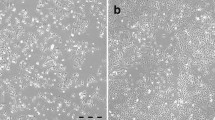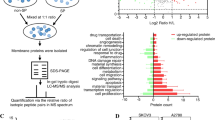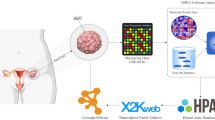Abstract
The existence of several model systems with which to investigate a particular disease is advantageous for researchers. This is especially true for ovarian cancer, which, due to its complex and heterogeneous nature, inherently requires a large number of model systems. Here, we report a new ovarian serous adenocarcinoma cell line, designated YDOV-157, and characterized via post genomics and post proteomics. In this study, primary culture of tumor cells from ascites was performed and the cells were immortalized up to at least 60 passages in vitro. We studied the morphologies, cell proliferation, BRCA1/2 mutations, tumorigenesis capacity, and chemosensitivity of YDOV-157. Using a cDNA microarray, differentially expressed genes were identified and some of them were validated. Using proteomic analysis, we identified proteins that were differentially expressed in YDOV-157. The newly derived cell line, designated YDOV-157, grew as a monolayer and the doubling time was 102 h. When transplanted into nude mice, it initiated the formation of tumor masses with microscopic findings identical to those of the primary tumor. Chemosensitivity test showed that paclitaxel induced the highest chemosensitivity index. In microarray analysis, 2,520 probes were differently expressed, compared to human ovarian surface epithelial cells (HOSEs). In SYBR Green real-time PCR, the expression of E2F2 (P = 0.040) and CRABP2 genes (P = 0.030) was significantly higher in the ovarian cancer cell lines than in HOSEs. Furthermore, proteomic analysis showed that expression of 28 spots was significantly altered between YDOV-157 and HOSE. In conclusion, the newly derived YDOV-157 cell line may be an important research resource for studying cancer cell biology and should also be very useful for developing new strategies that inhibit cancer cell growth and progression.






Similar content being viewed by others
References
Jemal A, Siegel R, Ward E et al (2007) Cancer statistics, 2007. CA Cancer J Clin 57:43–66
Landis SH, Murray T, Bolden S et al (1998) Cancer statistics, 1998. CA Cancer J Clin 48:6–29. doi:10.3322/canjclin.48.1.6
Mok CH, Tsao SW, Knapp RC et al (1992) Unifocal origin of advanced human epithelial ovarian cancers. Cancer Res 52:5119–5122
Tsao SW, Mok CH, Knapp RC et al (1993) Molecular genetic evidence of a unifocal origin for human serous ovarian carcinomas. Gynecol Oncol 48:5–10. doi:10.1006/gyno.1993.1002
Abeln EC, Kuipers-Dijkshoorn NJ, Berns EM et al (1995) Molecular genetic evidence for unifocal origin of advanced epithelial ovarian cancer and for minor clonal divergence. Br J Cancer 72:1330–1336
Wingo PA, Ries LA, Rosenberg HM et al (1998) Cancer incidence and mortality, 1973–1995: a report card for the US. Cancer 82:1197–1207. doi :10.1002/(SICI)1097-0142(19980315)82:6<1197::AID-CNCR26>3.0.CO;2-0
Garson K, Shaw TJ, Clark KV et al (2005) Models of ovarian cancer-are we there yet? Mol Cell Endocrinol 239:15–26. doi:10.1016/j.mce.2005.03.019
Kim JW, Lee CG, Lyu MS et al (1997) A new cell line from human undifferentiated carcinoma of the ovary: establishment and characterization. J Cancer Res Clin Oncol 123:82–90. doi:10.1007/BF01269885
Yuan Y, Kim WH, Han HS et al (1997) Establishment and characterization of human ovarian carcinoma cell lines. Gynecol Oncol 66:378–387. doi:10.1006/gyno.1997.4785
Ramakrishna V, Negri DR, Brusic V et al (1997) Generation and phenotypic characterization of new human ovarian cancer cell lines with the identification of antigens potentially recognizable by HLA-restricted cytotoxic T cells. Int J Cancer 73:143–150. doi :10.1002/(SICI)1097-0215(19970926)73:1<143::AID-IJC22>3.0.CO;2-G
Guo HF, Feng J, Liu G et al (2005) Establishment and characterization of a human ovarian sarcomatoid carcinoma cell line BUPH:OVSC. Int J Gynecol Cancer 15:856–865. doi:10.1111/j.1525-1438.2005.00148.x
Navabi H, Croston D, Hobot J et al (2005) Preparation of human ovarian cancer ascites-derived exosomes for a clinical trial. Blood Cells Mol Dis 35:149–152. doi:10.1016/j.bcmd.2005.06.008
Indraccolo S, Tisato V, Agata S et al (2006) Establishment and characterization of xenografts and cancer cell cultures derived from BRCA1 −/− epithelial ovarian cancers. Eur J Cancer 42:1475–1483. doi:10.1016/j.ejca.2006.01.057
Carr TM, Adair SJ, Fink MJ et al (2008) Immunological profiling of a panel of human ovarian cancer cell lines. Cancer Immunol Immunother 57:31–42. doi:10.1007/s00262-007-0347-7
Gagne JP, Gagne P, Hunter JM et al (2005) Proteome profiling of human epithelial ovarian cancer cell line TOV-112D. Mol Cell Biochem 275:25–55. doi:10.1007/s11010-005-7556-1
Friedman LS, Ostermeyer EA, Szabo CI et al (1994) Confirmation of BRCA1 by analysis of germline mutations linked to breast and ovarian cancer in ten families. Nat Genet 8:399–404. doi:10.1038/ng1294-399
Wagner T, Stoppa-Lyonnet D, Fleischmann E et al (1999) Denaturing high-performance liquid chromatography detects reliably BRCA1 and BRCA2 mutations. Genomics 62:369–376. doi:10.1006/geno.1999.6026
Gross E, Arnold N, Pfeifer K et al (2000) Identification of specific BRCA1 and BRCA2 variants by DHPLC. Hum Mutat 16:345–353. doi :10.1002/1098-1004(200010)16:4<345::AID-HUMU7>3.0.CO;2-#
Moon YW, Choi SH, Kim YT et al (2007) Adenosine triphosphate-based chemotherapy response assay (ATP-CRA)-guided platinum-based 2-drug chemotherapy for unresectable nonsmall-cell lung cancer. Cancer 109:1829–1835. doi:10.1002/cncr.22601
Shevchenko A, Wilm M, Vorm O et al (1996) Mass spectrometric sequencing of proteins silver-stained polyacrylamide gels. Anal Chem 68:850–858. doi:10.1021/ac950914h
Yamada K, Tachibana T, Hashimoto H et al (1999) Establishment and characterization of cell lines derived from serous adenocarcinoma (JHOS-2) and clear cell adenocarcinoma (JHOC-5, JHOC-6) of human ovary. Hum Cell 12:131–138
Alama A, Barbieri F, Favre A et al (1996) Establishment and characterization of three new cell lines derived from the ascites of human ovarian carcinomas. Gynecol Oncol 62:82–88. doi:10.1006/gyno.1996.0194
Hill BT, Whelan RD, Gibby EM et al (1987) Establishment and characterisation of three new human ovarian carcinoma cell lines and initial evaluation of their potential in experimental chemotherapy studies. Int J Cancer 39:219–225. doi:10.1002/ijc.2910390216
Langdon SP, Lawrie SS, Hay FG et al (1988) Characterization and properties of nine human ovarian adenocarcinoma cell lines. Cancer Res 48:6166–6172
Dolo V, Ginestra A, Violini S et al (1997) Ultrastructural and phenotypic characterization of CABA I, a new human ovarian cancer cell line. Oncol Res 9:129–138
Fuchtner C, Emma DA, Manetta A et al (1993) Characterization of a human ovarian carcinoma cell line: UCI 101. Gynecol Oncol 48:203–209. doi:10.1006/gyno.1993.1034
Scoles DR, Pavelka J, Cass I et al (2007) Characterization of CSOC 882, a novel immortalized ovarian cancer cell line expressing EGFR, HER2, and activated AKT. Gynecol Oncol 104:120–128. doi:10.1016/j.ygyno.2006.07.023
Marks JR, Davidoff AM, Kerns BJ et al (1991) Overexpression and mutation of p53 in epithelial ovarian cancer. Cancer Res 51:2979–2984
Okamoto A, Sameshima Y, Yokoyama S et al (1991) Frequent allelic losses and mutations of the p53 gene in human ovarian cancer. Cancer Res 51:5171–5176
Ford D, Easton DF, Bishop DT et al (1994) Risks of cancer in BRCA1-mutation carriers. Breast Cancer Linkage Consortium. Lancet 343:692–695. doi:10.1016/S0140-6736(94)91578-4
Cass I, Baldwin RL, Varkey T et al (2003) Improved survival in women with BRCA-associated ovarian carcinoma. Cancer 97:2187–2195. doi:10.1002/cncr.11310
Acknowledgments
This work was supported in part by National R&D Program for Cancer Control, Ministry of Health and Welfare, Republic of Korea (7-2006-0153), CMB-YUHAN research grant of Yonsei University College of Medicine for 2006 (6-2006-0030), and the Korea Research Foundation Grant funded by the Korean Government (MOEHRD, Basic Research Promotion Fund) (KRF-2006-311-e00339).
Author information
Authors and Affiliations
Corresponding author
Rights and permissions
About this article
Cite this article
Cho, H., Kang, E.S., Hong, S.W. et al. Genomic and proteomic characterization of YDOV-157, a newly established human epithelial ovarian cancer cell line. Mol Cell Biochem 319, 189–201 (2008). https://doi.org/10.1007/s11010-008-9892-4
Received:
Accepted:
Published:
Issue Date:
DOI: https://doi.org/10.1007/s11010-008-9892-4




